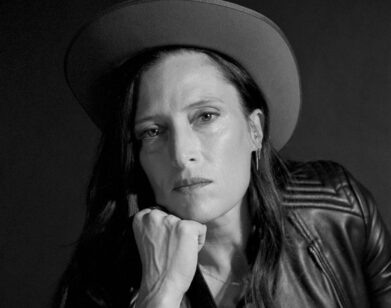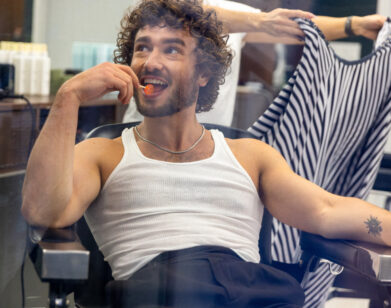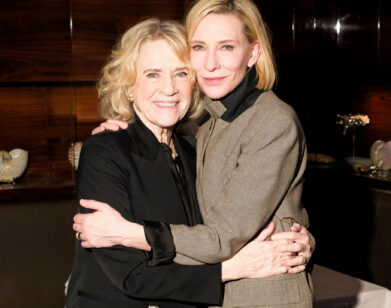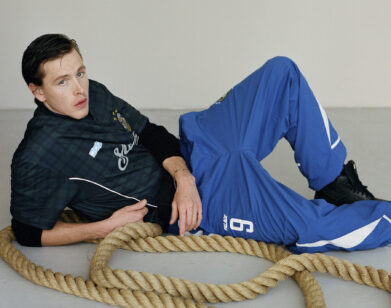The Women of Anna Karina
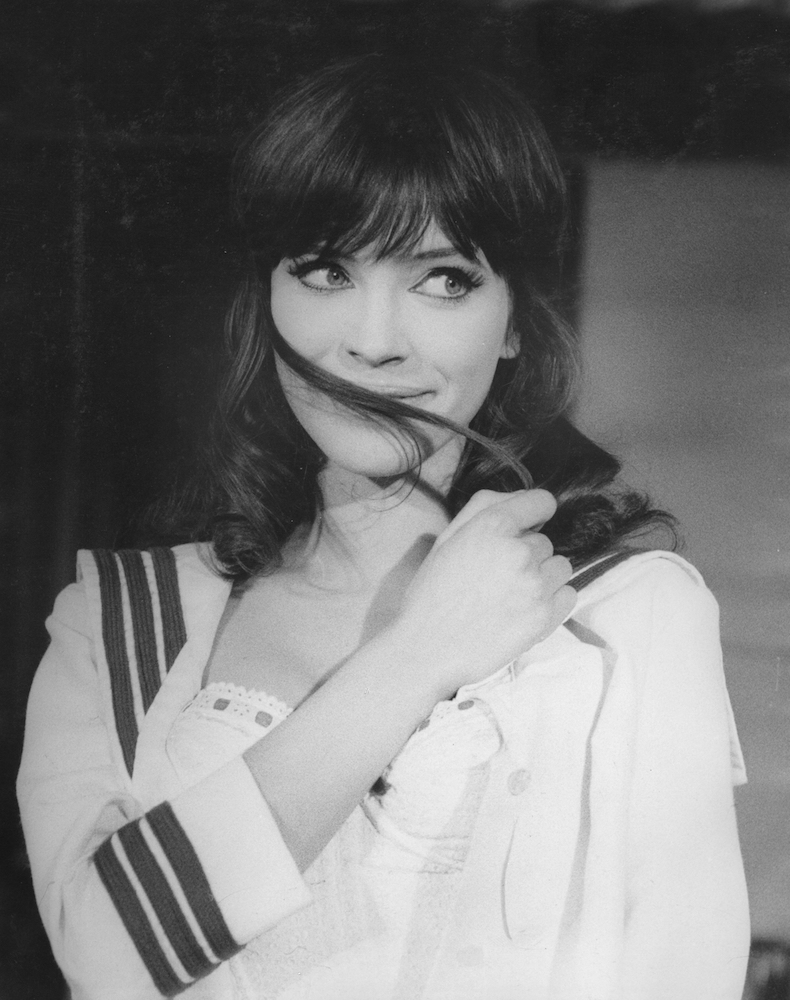
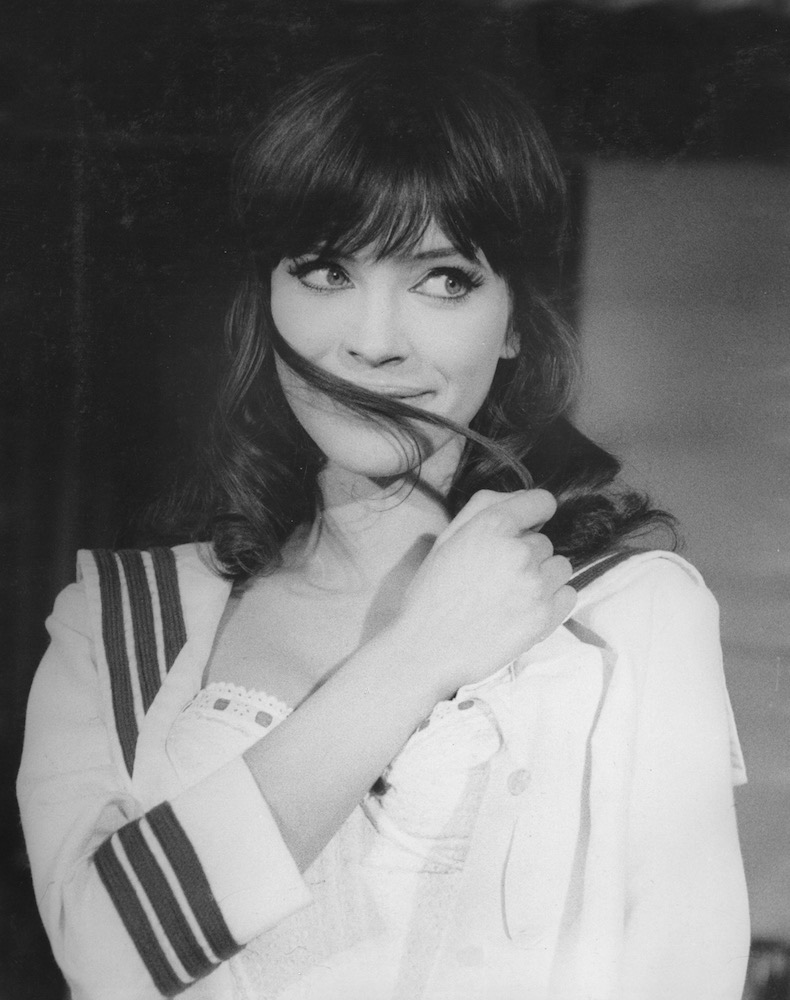
Anna Karina in “A Woman is a Woman,” courtesy of Pathé Contemporary Films/Photofest.
Roland Barthes wrote of the magical “face-object” of Greta Garbo that, when projected onscreen, it drove movie house audiences to ecstasy. Decades later, Anna Karina elicited the same kind of transformative magnetism in her work with New Wave director Jean-Luc Godard, her indelible face filling the frame, all wide eyes, sculpted feline features, and choppy little bangs.
Great actresses come dressed with an inherent mythic quality, and Karina, born Hanne Karin Blarke Bayer in Denmark in 1940, has one of those origin stories that would do well to be made into a movie itself. Releasing herself from a turbulent home life, Karina hitchhiked to Paris as a teenager and was discovered by a model scout at Left Bank café and Sartre and de Beauvoir hangout Les Deux Magots. She booked work for Chanel and Pierre Cardin before the famous, oft-repeated legend—Godard spotting Karina in a Palmolive soap commercial, asking her to play a nude role in his feature debut, Breathless, and her refusing—jumpstarted her acting career. Their creative and romantic relationship, which began with 1961’s Le Petit Soldat and lasted until their 1965 divorce and final film together, Made in U.S.A. (1966), had Karina acting as not just muse, but active collaborator in building Godard’s iconoclastic style.
No matter the staging—the breakneck run through the Louvre and finger-snapping dance sequence in Band of Outsiders(1964); the striptease musical number in A Woman is a Woman (1961); the haunting, tears-streaming close-up in My Life to Live (1962); her fugitive sylph in Pierrot le Fou (1965)—Karina’s impish physicality and emotional frailty made her an icon. But her subsequent work with other filmmakers including Jacques Rivette (The Nun, 1966), Luchino Visconti (The Stranger, 1967), Tony Richardson (Laughter in the Dark, 1969), George Cukor (Justine, 1969), and Rainer Werner Fassbinder (Chinese Roulette, 1976) stands up on its own as well. She also had a major hit with her pop single “Roller Girl” written by Serge Gainsbourg, released her directorial debut, Vivre ensemble, in 1973 (the film premiered at Cannes), and has published four novels.
Tonight, Karina, 75, will make a special appearance at BAM accompanying a screening of A Woman is a Woman, and starting Friday, Film Forum will run their series “Anna & Jean-Luc,” a survey of the director and actress’s work including the a new restoration of Band of Outsiders. We spoke to Karina by phone last week while she was at her hotel in Los Angeles, sitting next to a statue of Charlie Chaplin.
———
COLLEEN KELSEY: Hi Anna, how are you? I heard you’re in Los Angeles.
ANNA KARINA: I am with my husband Dennis, I am having a great time and tonight I am showing A Woman is a Woman. I am sitting next to Charlie Chaplin. It’s a statue in the hotel outside. We took a picture of it. [Laughs]
KELSEY: You were re-christened Anna Karina by Coco Chanel. How did that come about?
KARINA: It happened by accident. I came to the showroom to show pictures, and she said, “Okay, we’ll make a test to see if you can do it.” I was a little girl—about 17-and-a-half—and so I went into the makeup room and I did my makeup, and my hair, and the eyes to get them a little bit bolder. This woman came in with a big hat, she was 66 or 65 or something like that, but very beautiful! Kind of militaire. She said, “What is your name little girl?” I was talking to the makeup lady, and said, “My name is Hanne Karin Bayer.” She said, “Hanne Karin Bayer? And you want to be an actress? You’ve got to call yourself Anna Karina.” And I said, “Oh that sounds good, thank you, Madame.” Afterwards everybody told me it was Coco Chanel. Two weeks later I got my photo on the cover of Elle magazine and I really got work. That was a big honor at the time, and they called me “Anna Karina,” but they spelled it the wrong way in the beginning, with a “C,” the Italian way.
KELSEY: How long were you in Paris before you started modeling and acting in commercials?
KARINA: Everything went so quickly. I didn’t love it; it was money for me and I didn’t have any. At that time you could go to the movie houses non-stop from 12:00 pm until midnight and just pay a little bit. And you could smoke. So I would see the film about five times. The same film. Of course I would learn something. I would see them shake the hand and say “Bonjour,” you know? I loved the films of Jean Gabin. It was good to get the kind of swing of French.
KELSEY: How did you first meet Godard?
KARINA: Jean was getting more popular, right? I made films for soaps and I was the Coca-Cola girl for England. I did a lot popular films, too. Suddenly I had a call one day saying they’d like me to come to the office to see Jean-Luc Godard. “He is preparing a film called Breathless. Jean would like to see you.” I said yes. I thought he was pretty strange, because at that time nobody was wearing those kind of glasses where you couldn’t see the eyes. Like sunglasses, but it was not sunglasses. He says, “Okay, okay… you’re playing a girl taking her clothes off. You don’t mind?” I said, “Yes I do. I don’t want to take my clothes off.” So I walked off.
You know when he does the film… everybody is talking about it. It’s going to Cannes and all that. So I did another [meeting]. They said, “Will you come to the office to see Jean-Luc Godard?” I didn’t remember his name. I said, “Isn’t that the guy with the dark glasses who asked me to take my clothes off?” They said, “That’s him.” So I said, “I don’t want to go. I don’t think it’s true. It’s just a joke. He can’t be true.” They said, “You have to go because everybody is talking about Breathless saying it’s a good film, it’s great, it’s perfect.” So I go there and of course I said the same thing, “I don’t want to take my clothes off.” And he says, “Well you don’t have to take your clothes off.” Jean-Luc Godard walks around me and he says, “Okay.” “But what’s it about?” He said, “It’s a political film.” I said, “But I can’t. I can’t play… It’s uncomfortable. I couldn’t make a speech.” He said, “You don’t have to worry about that. You come tomorrow and sign your contract.”
I said, “Well, you know I can’t come and sign it tomorrow because I am underage.” You had to be 21 at the time and I was about 18 and a half. So I phoned my mother in Denmark and said, “Mommy, you know, I am sorry we haven’t talked in a long time, but now I have to do a political film and you have to come and sign because I am underage.” She said, “Have you lost your mind?” Then she hangs up. So I phone again and I said, “Mommy, it’s true.” So she came and she signed the contact. That’s how I became Veronique in Le Petit Soldat directed by Jean-Luc Godard.
KELSEY: What was your collaborative process like for all the films after Le Petit Soldat? Would he have an idea and bring it to you and you would talk about it?
KARINA: Well, we did not ever really talk about it. Every time he did a film, he would say… it was a kind of comedy and I was stripper, you know with all these women, [like in A Woman is a Woman]. There was no script. He got an idea, because every time he went to the do a take, we would find out what kind of things we had to do. It became very natural. You don’t always have to read everything about something to understand what you are doing. Even if you get it at the last minute, you know. It was kind of rhetoric… “Just do it like this or like that.” He took actors because he knew they could do what he wanted, like being natural walking around, lighting a cigarette and drinking a glass of something, or sitting down to talk, or run away and do something. He would never take actors who couldn’t do that kind of thing.
KELSEY: How was that for you developing as an actress? Did it just make embodying a role very instinctual?
KARINA: It was just like gifts all the time, when somebody gives you something very, very fantastic. Also, it could be so difficult. I don’t look the same way in A Woman is a Woman as in My Life to Live or in Pierrot Le Fou. I am still very different every time. In Pierrot Le Fou it’s very different part. I don’t have the same kind of skin, haircut. All the actors, most of the time, would change their haircut, change their look. That was very interesting. I really liked that. But of course it’s better to be the same all the time because then people remember you better, I guess. I really am very, very proud. It was really a great, great gift for me to do all that. In-between, of course, I worked with other directors. That was fun too.
KELSEY: When did your working relationship with Godard turn romantic?
KARINA: It all began in Switzerland when did Le Petit Soldat. We fell in love. It was very bizarre, because it was like nobody could do the first step. We were looking at each other, like something bizarre and very exciting at the same time, getting nervous about it. It took a long time before something happened. We were working together everyday. And then, it happened. After a while we got married. He taught me a lot. He taught me all that because he knows everything about painting, about writing, the great directors. It was like Pygmalion.
KELSEY: At the time, did it feel like you were working on something important, or completely new, in cinema?
KARINA: We didn’t realize at the time. We could change clothes in the street behind a tree if it was necessary. We were not asking for trailers and all that like most actors today. We were not difficult, and very happy to do the film. It was another world at the time.
KELSEY: I wanted to ask about the first film you directed, Vivre Ensemble—when did you realize you wanted to direct?
KARINA: It’s a love story, in a way. She is a bit hippie and he is a bit serious, and then they fall in love and she gets pregnant and has this child and then he kind of goes the other way. It’s not too funny, but it was funny to do it, because after, in ’72, I wanted to do a film that I produced myself with my little money and we went to New York to do one week in New York. It was really fun to do. I think personally that every actress should do a little film. Even a short film. And all directors should act, to know how difficult it is also the other way around.

